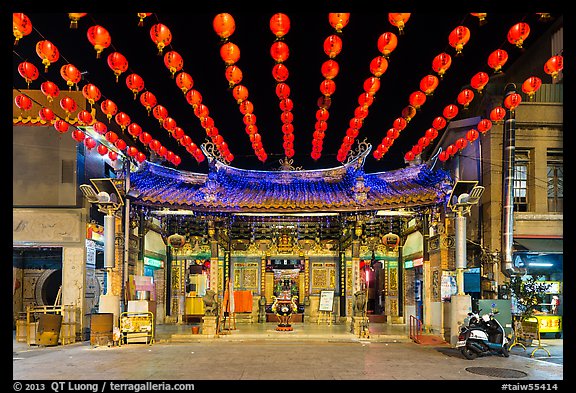Lukang, Taiwan – image sequence explained
No Comments
Taichung is linked to Taipei by a High Speed Rail line, whereas there is no train station in Lukang because in the past the city refused to allow railroads to pass through. This, combined with the silting of its port, led to Lukang’s economic decline. However, that economic decline averted the modernization that demolished historical buildings elsewhere, preserving buildings dating from Lukang’s heyday as an important trading port with mainland China.
For a contrast with Taipei, I traveled to Lukang to see old Taiwan. It took almost as much time to travel from nearby Taichung to Lukang than it did from Taipei to Taichung. Sitting on a local bus, it’s never clear when I have arrived, since all the signs are in Chinese that I can’t read. Instead of a proper bus station or stop, the bus arrived in a dark depot with no businesses around. The spot was sketchy-looking, but when I asked the driver “Lukang ?”, he nodded. I began to wander the streets, still a bit shaken by this arrival, until I ran into this scene. From there, I knew that some wonderful exploring lied ahead.

For this particular blog post, I am not going to embed more images, instead referring you to my main site. When I embed images in a blog post, their order often follows my story. However, on the photo galleries, this order is usually different, as it aims to tell a story about a place rather than about me. You’ll notice that it finishes with the first subject I actually photographed. In the rest of this post, I am going to explain my sequencing of the Lukang photo gallery – link opens a new window so that you can follow comments below.
- We begin our exploration of the city with a typical, busy, modern commercial street, which is what your first impression of the city would be.
- If you look more closely at sidewalks on even such a generic street, you’ll see a glimpse of the past, such as traditional craftmen at work. Wu Tun-Hou Lantern shop is one of the most renowned in Taiwan.
- We now move into a network of twisting narrow alleys. The visual link between the first three images are the paper lanterns. There are a few people in the alley besides the man on bicycle.
- Next, there is only a man on bicycle left, and most of the image area is now taken by a building’s facade rather than the alley.
- We now see a series of close-ups of facades and doors with nobody. The visual link between the last three images are the bicycles.
- We zoom from a facade to a door detail, then back again but with the buildings showing more sign of wear. Images are tied by several elements such as the Chinese characters on red around the door, inside the door, blue color, Chinese characters in white around the doors.
- We jump from one entrance (a modest grey weathered door) to another (the Hall of five gates, Longshan Temple, whose dragons carved in greyish rock are one of the most famous symbols of Taiwan). All the images up until now had prominent Chinese script, which disappears from the next images as the subjects switch to the spiritual.
- After entering through the gate, we walk into the main courtyard of Longshan Temple (site of four images) then attend a Buddhist religious service in the main section of the temple. Upon exiting, we take a look above us, noticing an intricate wooden plafond ceiling.
- It is now dark as make a similar visit to the other noted temple in Lukang, the Matzu Taoist Temple (site of three images), walk through its gate, into its courtyard, then to its main altar. Matzu is one of the most venerated deities in Taiwan, and this particular figure has been blacked by centuries of exposure to incense.
- We are then out, but like in the previous image, an altar – this one anonymous – is still visible in the distance.
- We continue to wander in alleys, which are the theme of those three images. They become progressively less dark, and the space more public.
- Guided by the paper lanterns which are the link between the last three images – as they were the link between the three first images – we end up back on the street, where we started. In addition to shops, there is also a temple in this concluding image to remind us of everything we’ve seen in this journey.
Here you are, I hope to have provided you with a new appreciation of the thought that goes behind my image presentation. Almost each of my photo gallery pages is carefully sequenced, although the sequencing method varies. In addition, they need to show a representative sample of images. It’s much more work than throwing together a bunch of images randomly !
Did you notice some of my sequencing elements ? Do you think that the image sequence matters when viewing the photo galleries ?

